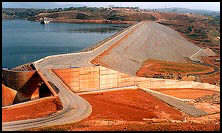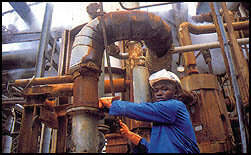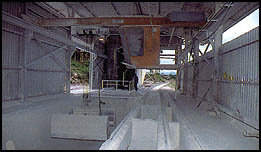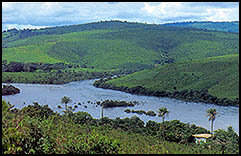 ENERGY: POWER POTENTIAL BEYOND BORDERS ENERGY: POWER POTENTIAL BEYOND BORDERS |

One of the necessary conditions for creating sustainable industrial development is to develop the energy sector and increasing the consumption of the energy. This is one of the sine qua non conditions of any economy which must respond and satisfy the needs of the companies and the populations.
Guinea offers huge opportunities in the energy sector. The Minister of Energy, Mr. Niankoye Sagno declares that " this potential, if exploited correctly, could provide electricity to the whole of Guinea and also export our energy to neighboring countries." Guinea possesses extremely rich water resources, hence the name given to Guinea by many experts, "The Water Tower of Guinea". Not only are numerous rivers born here, but the amount of heavy annual rain falls cannot be compared. Experts have evaluated Guinea's total power potential to 6000MW. The current production is minimal compared to the possibilities of the sector: 44 MW in 1992, 95 MW in 1995 and since the construction of the Garifiri Dam an additional 75 MW are available.
The important needs of the sector have led the state to call upon private companies to manage and reform the sector. In this regard, the state has created ENELGUI (Entreprise Nationale d'Electricité) to which the state has transferred the entirety of infrastructures and future investments. It then called upon the international group HYDRO-QUEBEC to deal with the distribution. The latter joint venture agreement gave way to the monopoly SOGEL (Société Guinéenne d'Electricité), which has the sole rights to produce, transport and distribute electricity in the country.
An agreement signed between SOGEL and the government on July 25th 1994 is for a ten-year period. The goal of this agreement is to improve the production and the management of electricity. The rate of production is still a real concern, however. Nearly two thirds of the electricity production is a lost, producing only 37% of its potential. These losses originate from the fact that most of the current equipment is old and because of ongoing fraud problems or the simple refusal to pay electricity bills. The latter creates a revenue loss of 16 billion GNF which represents 40% of administered electricity. But as Minister M. Sagno says: "The salary of a Guinean is around 100 to 150 dollars a month and at the same time the cost of the electricity is very high, given that the amount of electricity consumed is positively correlated with the cost." Electricity represents between 20 to 40% of workers wages, which is why less than 10 % of the population have access to electricity.
"The main objective of the government is to reduce poverty and improve the living conditions of the population", states the Minister of Energy. In this sense Guinea's main hope is the Garafiri Dam, the most important construction since independence. Sagno insists that the "construction of Garafiri shows the willingness of the Guinean people to progress and build a modern country".
Officially inaugurated on July 22, 1999 by France's President Jacque Chirac, the Garifiri Dam built on the Konkowe river is 75m high and 725m long. It cost a total of 230 million USD and was funded by the French Agency for Development (22%); the Canadian agency for international development (10%), the European Bank for Investment (14%) and some Arab Funds including the Islamic Development Bank, the Arab Bank for African Development, the Kuweity fund, and some Saudien founds, all of which represent 38%. The Guinean government also took part in 16% of the funding after the withdrawal of the World Bank.

The plant provides for the time being electricity only to Maritime Guinea and Fouta Djallon. For this reason the government realizes the neet to expand its infrastructure in the sector. the existence of quite a number of projects are already in the pipeline. Among them is the largest and oldest Suapiti Kaleta project, which was elaborated before independence. The construction of the Suapititi Dam in addition with that of the Garafiri Dam will supply a total of a one thousand megawatt to the Guinean people. This will produce sufficient electricity for the aluminium plant which will have a production of 300,000 tons and the population that lives around it. GAMCO just signed an agreement with the government for the realization of this project, but is still looking for financing evaluated at 1 billion USD.
| Guinea has a number of sites and rivers with possibilities to build dams. "We are ready to find solutions in order to provide electricity for the entire population and small scale industries", said Sagno. The project in Fome which plans to produce 90,000 megawatts could even provide electricity to the Republic of Mali.
Water is also a key element in the Energy sector as it is coupled with public health and the improvement of the population's living conditions. The government in 1989 therefore drafted the division of this sector into two companies: Soneg, (Societe Nationale des Eaux de Guinée) is the company in charge of servicing the dept of the sector and controlling the exploitation,.and SEEG (la Societe d'Exploitation des Eaux de Guienee), which has the rights to manage and distribute the water resources.

The total capacity of production has gone from 45 000m3 in 1989 to more than 150,000m3 in 1999. it has only been five years since water is supplied 24 hours a day compared to 8 hours a day in 1989. The number of subscribers has also increased from 11,000 to 51,000 with a network density allowing 5,000 additional subscribers per year. SEEG's capital has gone from 2.5 million USD in 1990 to 9 million USD in 1999 with a rate of return from 10% to 85%.
Today, the water sector is in grave need of investment. Eight cities still have no access to water and the price of water subscription is still consideredtoo high for some. Therefore, the two companies working together have proposed investment program to the government over a ten-period totaling the amount of 26 million USD. This project favors individual consumers. If adopted it will reduce the price of water to 7 USD compared to a 160 USD today. The two companies also committed to reach performance conditions, which could lead to negative sanctions in the case they fail to fulfill them.

Finally concerning this sector, the government must pay detailed attention to petroleum sales. All international Oil companies are present in Guinea. The departments in charge of the oil sector are energy, mine and geology, and commerce and industry. Societe Generale de Petrole whose role is to receive, stock and deliver to the sellers, and the Groupement des Producteurs de Pétrole, which make up plans for the supply and make the orders for an international offer are the main actors dealing with oil. An element to be noted is the problem of fixed oil prices instilled by the government. The fixed price and the cost are never the same. The government has established a special tax on petroleum products, and is undertaking special measures to liberalize the price at gas stations before the end of the year 2000. The activity of both companies are exclusively linked with the distribution of their product as the petroleum code requests: "Any petroleum company can, if desire, practice the activities of researchers in the national territory and the national waters". But the companies have not yet started to search petroleum. Concerning the researchers, Mr Ibrahim Soumah, the Minister of Mines explains that "one year ago, researchers oriented themselves towards deep waters and along the coast. Taking into account the technical progress this will permit to give the result to the companies that are interested." there are certain similarities found near the coast of guinea and those found near Nigeria, which gives hopes to experts that are possibilities of finding crude oil. |

